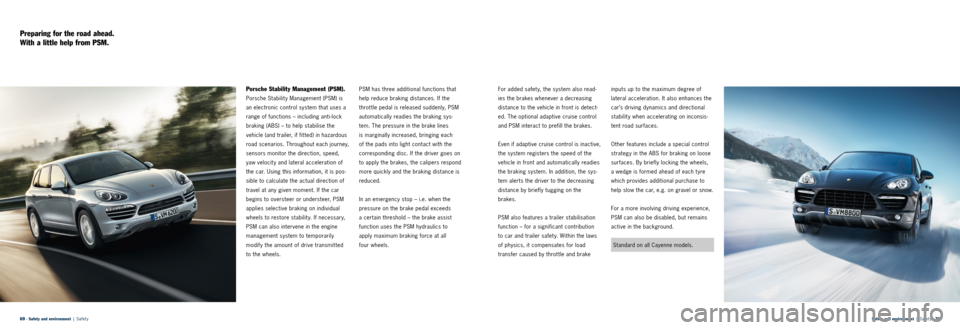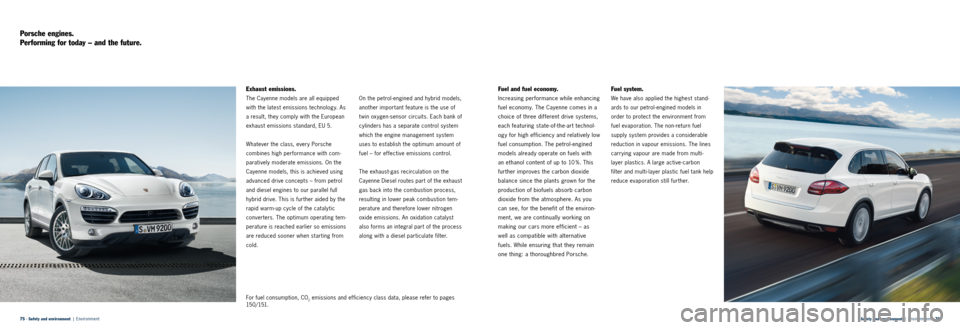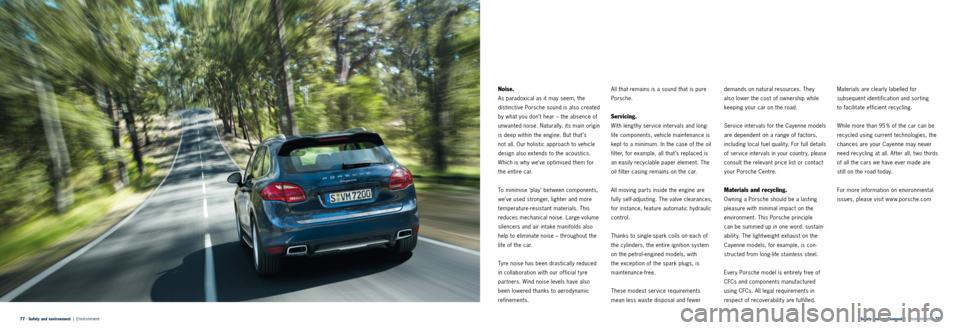ABS PORSCHE CAYNNE 2013 2.G Information Manual
[x] Cancel search | Manufacturer: PORSCHE, Model Year: 2013, Model line: CAYENNE, Model: PORSCHE CAYENNE 2013 2.GPages: 79, PDF Size: 14.97 MB
Page 26 of 79

Drive systems and chassis | Off-road capability · 52
51 · Drive systems and chassis | Off-road capability
From urban jungle to the windy wilds.
The Cayenne is perfectly at home on any terrain.
Off-road capability.
Steep ascents leading to snow- covered
mountain lodges, boggy ground or
muddy, loose surfaces – all situations
that the Cayenne handles superbly with
intelligent all-wheel drive. The drive
systems featured on the Cayenne models
deliver exceptional torque. For plent y of
power on tap. On any terrain.
Operating concept.
With the help of Porsche Traction
Management (PTM), the Cayenne can
cope with even the most demanding
off-road scenarios. Simply move the
main off-road control on the centre
console forward or backward to select
one of up to three off-road modes
(depending on the model). Available
on the Cayenne, Cayenne Diesel,
Cayenne S, Cayenne GTS and Cayenne
Turbo, this
function readies the car for
off-road use or reverts the set ting to
normal road driving.
In Off-road Mode 1, for example, the
maps for all relevant systems, e.g. ABS,
are adapted to provide optimum traction.
In addition, High Level I is selected
on vehicles featuring air suspension
with PASM. If that ’s not enough, the air
suspension can be raised further to
High Level II to increase the approach/
departure angle and wading depth.
1)
Push the off-road control forward again
on the Cayenne, Cayenne S, Cayenne GTS
and Cayenne Turbo to activate Off-road
Mode 2 – for even greater traction on difficult terrain, the multi-plate clutch can
be fully locked.
The electronically variable rear diffe
r-
ential on the optional Porsche Torque
Vectoring Plus (PT V Plus, p. 56) is inte -
grated within the all-wheel drive system.
This automatically ensures the optimum
distribution of drive torque on particular -
ly uneven surfaces. If one of the rear
wheels begins to slip, the rear differential
varies the amount of torque transmit ted
through each drive shaft, thereby restor -
ing traction. In Off-road Mode 3, the rear
differential can be manually locked using
the main off-road control. Then both
rear wheels receive the same amount of
torque, regardless of surface conditions.
The optional PDCC (p. 55) enables greater wheel articulation in all three
modes, improving traction still further.
For effective prevention of damage to the
underside of the car, all Cayenne models
can be equipped with optional off-road
underbody protection comprising rock
rails with integrated skid plates, a
reinforced engine-bay guard, additional
protection for fuel tank and rear axle,
and a second towing lug.
1) The Cayenne GTS has a steel -spring spor ts suspension with a 24 mm reduction in ride height (20 mm reduction with optional air suspension). This will lead to restricted capabilit y when driving of f road.
Main off-road control
Page 35 of 79

Safety and environment | Safet y · 70
69 · Safety and environment | Safet y
Porsche Stability Management (PSM).
Porsche Stabilit y Management (PSM) is
an electronic control system that uses a
range of functions – including anti-lock
braking (ABS) – to help stabilise the
vehicle (and trailer, if fit ted) in hazardous
road scenarios. Throughout each journey,
sensors monitor the direction, speed,
yaw velocit y and lateral acceleration of
the car. Using this information, it is pos-
sible to calculate the actual direction of
travel at any given moment. If the car
begins to oversteer or understeer, PSM
applies selective braking on individual
wheels to restore stabilit y. If necessary,
PSM can also intervene in the engine
management system to temporarily
modify the amount of drive transmitted
to the wheels. PSM has three additional functions that
help reduce braking distances. If the
throt tle pedal is released suddenly, PSM
automatically readies the braking sys
-
tem. The pressure in the brake lines
is marginally increased, bringing each
of the pads into light contact with the
corresponding disc. If the driver goes on
to apply the brakes, the calipers respond
more quickly and the braking distance is
reduced.
In an emergency stop – i.e. when the
pressure on the brake pedal exceeds
a certain threshold – the brake assist
function uses the PSM hydraulics to
apply maximum braking force at all
four wheels.
Preparing for the road ahead.
With a little help from PSM.
For added safet y, the system also read -
ies the brakes whenever a decreasing
distance to the vehicle in front is detect -
ed. The optional adaptive cruise control
and PSM interact to prefill the brakes.
Even if adaptive cruise control is inactive,
the system registers the speed of the
vehicle in front and automatically readies
the braking system. In addition, the sys -
tem alerts the driver to the decreasing
distance by briefly tugging on the
brakes.
PSM also features a trailer stabilisation
function – for a significant contribution
to car and trailer safet y. Within the laws
of physics, it compensates for load
transfer caused by throt tle and brake inputs up to the maximum degree of
lateral acceleration. It also enhances the
car’s driving dynamics and directional
stability when accelerating on inconsis
-
tent road surfaces.
Other features include a special control
strategy in the ABS for braking on loose
surfaces. By briefly locking the wheels,
a wedge is formed ahead of each t yre
which provides additional purchase to
help slow the car, e.g. on gravel or snow.
For a more involving driving experience,
PSM can also be disabled, but remains
active in the background.
Standard on all Cayenne models.
Page 38 of 79

Safety and environment | Environment · 76
75 · Safety and environment | Environment
Exhaust emissions.
The Cayenne models are all equipped
with the latest emissions technology. As
a result, they comply with the European
exhaust emissions standard, EU 5.
Whatever the class, every Porsche
combines high performance with com -
paratively moderate emissions. On the
Cayenne models, this is achieved using
advanced drive concepts – from petrol
and diesel engines to our parallel full
hybrid drive. This is further aided by the
rapid warm-up cycle of the catalytic
converters. The optimum operating tem -
perature is reached earlier so emissions
are reduced sooner when starting from
cold. On the petrol- engined and hybrid models,
another important feature is the use of
t win oxygen-sensor circuits. Each bank of
cylinders has a separate control system
which the engine management system
uses to establish the optimum amount of
fuel – for effective emissions control.
The exhaust-gas recirculation on the
Cayenne Diesel routes part of the exhaust
gas back into the combustion process,
resulting in lower peak com bustion tem-
perature and therefore lower nitrogen
oxide emissions. An oxidation catalyst
also forms an integral part of the process
along with a diesel particulate filter.
Porsche engines.
Performing for today – and the future.
Fuel and fuel economy.
Increasing performance while enhancing
fuel economy. The Cayenne comes in a
choice of three different drive systems,
each featuring state-of-the-art technol -
ogy for high efficiency and relatively low
fuel consumption. The petrol-engined
models already operate on fuels with
an ethanol content of up to 10 %. This
further improves the carbon dioxide
balance since the plants grown for the
production of biofuels absorb carbon
dioxide from the atmosphere. As you
can see, for the benefit of the environ
-
ment, we are continually working on
making our cars more efficient – as
well as compatible with alternative
fuels. While ensuring that they remain
one thing: a thoroughbred Porsche.
Fuel system.
We have also applied the highest stand -
ards to our petrol- engined models in
order to protect the environment from
fuel evaporation. The non-return fuel
supply system provides a considerable
reduction in vapour emissions. The lines
carrying vapour are made from multi-
layer plastics. A large active-carbon
filter and multi-layer plastic fuel tank help
reduce evaporation still further.
For fuel consumption, CO
2 emissions and efficiency class data, please refer to pages
15 0/ 151.
Page 39 of 79

Safety and environment | Environment · 78
77 · Safety and environment | Environment
Noise.
As paradoxical as it may seem, the
distinctive Porsche sound is also created
by what you don’t hear – the absence of
unwanted noise. Naturally, its main origin
is deep within the engine. But that ’s
not all. Our holistic approach to vehicle
design also extends to the acoustics.
Which is why we’ve optimised them for
the entire car.
To minimise ‘play’ between components,
we’ve used stronger, lighter and more
temperature-resistant materials. This
reduces mechanical noise. Large-volume
silencers and air intake manifolds also
help to eliminate noise – throughout the
life of the car.
Tyre noise has been drastically reduced
in collaboration with our official t yre
partners. Wind noise levels have also
been lowered thanks to aerodynamic
refinements. All that remains is a sound that is pure
Porsche.
Servicing.
With lengthy service intervals and long-
life components, vehicle maintenance is
kept to a minimum. In the case of the oil
filter, for example, all that ’s replaced is
an easily recyclable paper element. The
oil filter casing remains on the car.
All moving parts inside the engine are
fully self-adjusting. The valve clearances,
for instance, feature automatic hydraulic
control.
Thanks to single-spark coils on each of
the cylinders, the entire ignition system
on the petrol-engined models, with
the exception of the spark plugs, is
maintenance-free.
These modest service requirements
mean less waste disposal and fewer demands on natural resources. They
also lower the cost of ownership while
keeping your car on the road.
Service intervals for the Cayenne models
are dependent on a range of factors,
including local fuel quality. For full details
of service intervals in your country, please
consult the relevant price list or contact
your Porsche Centre.
Materials and recycling.
Owning a Porsche should be a lasting
pleasure with minimal impact on the
environment. This Porsche principle
can be summed up in one word: sustain -
abilit y. The light weight exhaust on the
Cayenne models, for example, is con -
structed from long-life stainless steel.
Every Porsche model is entirely free of
CFCs and components manufactured
using CFCs. All legal requirements in
respect of recoverability are fulfilled.
Materials are clearly labelled for
subsequent identification and sorting
to facilitate efficient recycling.
While more than 95 % of the car can be
recycled using current technologies, the
chances are your Cayenne may never
need
recycling at all. After all, t wo thirds
of all the cars we have ever made are
still on the road today.
For more information on environmental
issues, please visit www.porsche.com
Page 74 of 79

149 · Technical dataTechnical data · 150
CayenneCayenne DieselCayenne S
Chassis
Front a xle Extra-large format double wishbone
suspension, fully independent Extra-large format double wishbone
suspension, fully independentExtra-large format double wishbone
suspension, fully independent
Rear axle Multi-link suspension, fully independent Multi-link suspension, fully independentMulti-link suspension, fully independent
Steering Power-assisted, hydraulic Power-assisted, hydraulicPower-assisted, hydraulic
Brakes 6-piston monobloc aluminium fixed
calipers at front, 4-piston monobloc
aluminium brakes at rear, ABS 6-piston monobloc aluminium fixed
calipers at front, 4-piston monobloc
aluminium brakes at rear, ABS6-piston monobloc aluminium fixed
calipers at front, 4-piston monobloc
aluminium brakes at rear, ABS
Wheels 8.0J x 18 8.0J x 188.0J x 18
Ty r e s 255/55 R 18 255/55 R 18255/55 R 18
Unladen weightManual gearbox/ Tiptronic STiptronic STiptronic S
DIN 1,995 kg /2,030 kg 2,080 kg 2,065 kg
EC
1)2,070 kg /2,105 kg 2,155 k g 2 ,14 0 k g
Permissible gross weight 2,865 kg /2,900 kg 2,940 k g 2,940 k g
Maximum payload 770 kg / 770 kg 760 k g 775 kg
PerformanceManual gearbox/ Tiptronic S Tiptronic STiptronic S
Top speed 230 km/ h / 230 km/ h 220 km/ h258 km/ h
0–100 km/h 7.5 secs/7.8 secs 7.6 secs5.9 secs
Flexibility (manual gearbox) in second
highest (5th) gear, 80 –120 km/ h 9.6 secs
––
Overtaking acceleration (automatic
transmission) 80 –120 km/ h 5.4 secs
5.3 secs4.0 secs
Cayenne S HybridCayenne GTS Cayenne Turbo
Extra-large format double wishbone
suspension, fully independent Extra-large format double wishbone
suspension, fully independent Extra-large format double wishbone
suspension, fully independent
Multi-link suspension, fully independent Multi-link suspension, fully independent Multi-link suspension, fully independent
Power-assisted, electro-hydraulic Power-assisted, hydraulic Power-assisted, hydraulic
6-piston monobloc aluminium fixed
calipers at front, 4-piston monobloc
aluminium brakes at rear, ABS 6-piston monobloc aluminium fixed
calipers at front, 4-piston monobloc
aluminium brakes at rear, ABS 6-piston monobloc aluminium fixed
calipers at front, 4-piston monobloc
aluminium brakes at rear, ABS
8.0J x 18 9.5J x 20 8.5J x 19
255/55 R 18 275/45 R 20 265/50 R 19
Tiptronic S Tiptronic S Tiptronic S
2,240 k g 2,085 kg 2,170 k g
2,315 k g 2,16 0 k g 2,245 k g
2,910 k g 2,940 k g 2,980 k g
670 kg 755 kg 710 k g
Tiptronic S Tiptronic S Tiptronic S
242 k m / h 261 k m / h 278 km/ h
6.5 secs 5.7 secs 4.7 secs
– – –
4.6 secs 3.8 secs 3.1 secs
1) The unladen weight (EC) complies with the relevant EC Directives and is valid for standard specification vehicles only. Some items of optional equipment can increase this weight.
The figure specified above includes 68 kg representing the driver and 7 kg for luggage. All information in respect of features, design, per formance, dimensions, weight, fuel consumption and running costs is correct at the time of publication.
Porsche reser ves the right to alter specifications and other product information without prior notice.
Technical data.
Page 77 of 79

155 · IndexIndex · 155
Index
Drive systems 28
‘Coasting’ 21
Electric machine 28
Hybrid module 28
Parallel full hybrid 28
Performance 31–36
Engine technology 38
Air intake system 42
Auto start/stop function 38
Common-rail injection system 40
Cooling systems 40
Direct fuel injection (DFI) 40
Engine management (electronic) 42
E-power button 30
Exhaust system 43
High-voltage battery 30
Lubrication 41
Sports exhaust system 43
Supercharging system 42
Turbocharging systems 42
Variable Turbine Geometry (VTG) 42
Variable valve timing 39
VarioCam Plus 39
Transmission 44
All-wheel drive 47
Anti-slip regulation (ASR) 47
Automatic brake differential (ABD) 47
Downhill assistance 48
Manual gearbox 44
Porsche Traction Management (PTM) 47
Tiptronic S 44
Off-road capability 50
Chassis 52
Air suspension 54
Front axle 53
Porsche Active Suspension
Management (PASM) 57
Porsche Dynamic Chassis Control
(PDCC) 55
Porsche Torque Vectoring Plus
(PT V Plus) 56
Power steering Plus 53
Rear axle 53
Self-levelling 54
Steel-spring suspension 54
Steering 53
Tyre Pressure Monitoring (TPM) 58
Ty r e s 5 8
Weight reduction 53
Wheels 58
Safety 62
Active safet y 62
Airbags 70
Anti-lock braking (ABS) 68
Automatic headlight activation 62
Automatic hold function 65
Bodyshell 71
Braking systems 65
Ceramic brakes 66
Cornering lights 63
Day time running lights 63
Headlights 63
Interior safety features 70, 71
ISOFIX 71
Lighting 62
Parking brake (electric) 65
Passive Safet y 70
Porsche Active Safe (PAS) 110
Porsche Ceramic Composite Brake
(PCCB) 66
Porsche Dynamic Light System
(PDLS) 63
Porsche Dynamic Light System Plus
(PDLS Plus) 63
Porsche Side Impact Protection
(POSIP) 70
Porsche Stabilit y Management (PSM) 68
Recuperation 66
Seat belt system 70
Taillights 63
Environment 72
Exhaust emissions 74
Fuel economy 75
Fuel system 75
Lightweight construction 72
Materials 77
Noise 77
Recycling 77
Ser vicing 77
Comfort 80
Adaptive sports seats 84
Anti-theft protection 102
Audio systems 90
Bluetooth
® 92, 93
BOSE
® Surround Sound System 98
Burmester
® High-End Surround
Sound System 96
CD/ DVD autochanger 90
CDR/CDR Plus audio system 90
Child seats 87
Climate control 100
Comfort memory package 84
Comfort seats 84
Compass display 80
Digital radio 95
Driver memory package 84
Electronic logbook 95
GTS sports seats 84
Heat and noise-insulating glass 100
Heated windscreen 100
Interior 80
Interior lighting 88
Mobile phone preparation 93
MP3 90, 91, 93
Multifunction steering wheel 80Navigation system
90
On-board computer 80
Online services 94
Panoramic roof system 104
Porsche Communication
Management (PCM) 90
Porsche Entry & Drive 102
Porsche Rear Seat Entertainment 88
Porsche Vehicle Tracking System
( P V T S) 10 2
Privacy glass 100
Radio 90
Rain sensor 102
Rear seats 87
Seat ventilation 85
Seat/steering wheel heating 85
Seats 84
Sport Chrono Package 95
Storage compartments 88
S u n r o o f 10 4
S u n s c r e e n 10 2
Telephone module 92
Touchscreen display 90
T V tuner 88, 92
Universal audio interface 93
USB port 90, 93
Voice control 93
Driver assistance systems 106
Adaptive cruise control with PAS 110
Automatic headlight activation 62
Automatically dimming mirrors 106
Comfort lighting package 100
Cruise control 106
Lane Change Assist (LCA) 109
Lane Departure Warning (LDW) 108
P a r k A s s i s t 10 6
Reversing camera 106
Speed limit indicator 111
Tr a n s p o r t 112
Loading Level 113
Loading options 112
Loadspace management system 117
Luggage compartment 112
Roof rails 115
Roof transport system 115
Tailgate (automatic) 113
Towbar systems 117
Personalisation 118
C o l o u rs 120
Exterior 120
I n t e r i o r 122–127
Porsche Exclusive 140
Factory collection 141
Panorama 142
Technical data 146